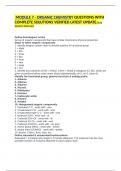Exam (elaborations)
MODULE 7 - ORGANIC CHEMISTRY QUESTIONS WITH COMPLETE SOLUTIONS VERIFIED LATEST UPDATE.Buy Quality Materials
- Course
- Institution
MODULE 7 - ORGANIC CHEMISTRY QUESTIONS WITH COMPLETE SOLUTIONS VERIFIED LATEST UPDATE.Buy Quality Materials Define homologous series Group of organic compounds that have similar chemical & physical properties Steps to name organic compounds 1. Identify longest carbon chain & include posit...
[Show more]



